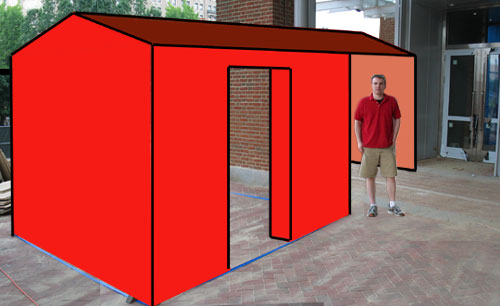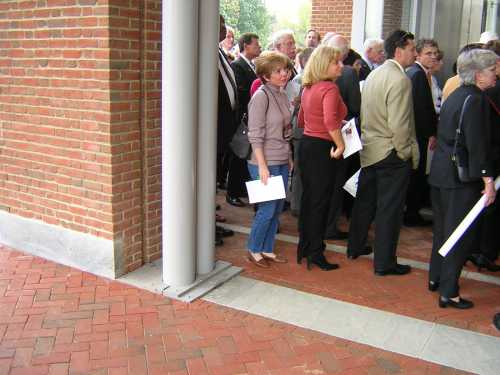The Slave Quarters Frequently Asked Questions
Several urban legends have surfaced regarding the President's House and the nine enslaved Africans who worked in George Washington's presidential household. This page attempts to separate the truth from the fiction. Please read other sections of this website for greater details on all of these issues.
Where and What are the Slave Quarters?
- Giles
- Paris
- (probably) Austin
- the white coachman Arthur Dunn
- Oney
- Moll
- Hercules
- Richmond
- Christopher
A 1785 map of the President's House property shows the smokehouse and an attached covered shed. In 1790, Washington's secretary wrote to him, "The Smoke-House will be extended to the end of the Stable, and two good rooms made in it for the accomodation [sic] of the Stable people." The stable people consisted of one white coachman and three enslaved black stableworkers.

According to Washington's correspondence, the Slave Quarters, marked in blue, housed:
Where did the others sleep?
Over the kitchen:In the attic of the main house:
None of the enslaved slept in the Servants Hall.

IHA intern Jonathan Parker poses outside the main entrance to the Liberty Bell Center. An artist has superimposed walls and a roof on the taped outline to suggest the 2-room structure of the Slave Quarters. Photo from the northwest.

On October 9, 2003, the Liberty Bell Center is opened to the public, as people, entirely unaware, are walking on the Slave Quarters.

The bricks indicate the southwest corner of the Slave Quarters. The main entrance to the Liberty Bell Center is less than five feet away.
See Slave Quarters Photo Album for more pictures.
Weren't the "slave quarters" within the house itself, as reported in the newspapers?
- No. Independence National Historical Park stated in the newspapers that slaves were housed in the Servants Hall. The Servants Hall was primarily a dining hall for the household's 24 servants, with two small lodging rooms for white servants at its south end. There is no evidence of any of the slaves being housed here.
Why was no archeology done at the Liberty Bell Center?
- Extensive archeology was done within the footprint of the Liberty Bell Center itself. However, the Slave Quarters fall just outside of the new building's footprint and therefore archeology was not done there.
Was archeology done on the site of the Slave Quarters?
- No. The documentary record indicates that in all likelihood nothing of the Slave Quarters remains. There is no doubt that the 19th and 20th century buildings (with fully-excavated basements) built on the site destroyed all traces of the Slave Quarters.
Did the Park Service's original proposed design for the President's House include the Slave Quarters?
- No, but it does now. The New York Times and The Christian Science Monitor both erroneously reported that the outline of the President's House — including the Slave Quarters — would be marked in the paving of the Liberty Bell Center entrance plaza. The Park Service's proposed outline of the house stopped at the Wash House (see map above), thus essentially erasing the Slave Quarters from historical memory.
Are there enslaved Africans buried at the President's House?
No, this is an urban legend. In 2000, human remains from an abandoned cemetery were found two blocks north of the President's House during the construction of the National Constitution Center, but these had nothing to do with the eight enslaved blacks that Washington brought to Philadelphia in 1790 or Joe (Richardson), who came in 1795.
Washington returned to Mount Vernon in March 1797 at the end of his presidency. Four of the nine enslaved blacks had been returned to Mount Vernon in 1791; two had escaped to freedom; one had died in Maryland; and two returned to Mount Vernon with Washington.
See the chart "What Became of the Nine?" on the Slavery Start Page.
Why are the Slave Quarters important?
- The majority of locations at the President's House were used by many members of the household. The Slave Quarters stands as a commemorative location used exclusively by the enslaved at the beginning of Washington's residence at the President's House. In this place we can commemorate the lives, dignity, fears, and struggles of the enslaved of African descent, in the context of power and unpower, of freedom and unfreedom in the making of our nation.
Did the Myrtilla, a ship known to have transported slaves, bring the Liberty Bell to America?
- As the Slave Quarters are a mere five feet from the door to the new Liberty Bell Center, some news articles reference the ship that brought the Liberty Bell to America. The Bell arrived on the Hibernia, captained by William Child. Isaac Norris, the man who oversaw the installation of the bell in the State House, wrote on Sept. 1, 1752, that the bell had recently arrived. The only ship from England that docked in Philadelphia during the month of August that year was the Hibernia, a ship of modest size, transporting dry goods and passengers regularly between England, the colonies and Ireland. No known records identify the Hibernia's owner either before or at the time it transported the bell. According to newspaper accounts of port activity, the Myrtilla docked in Philadelphia at the end of September 1752.




